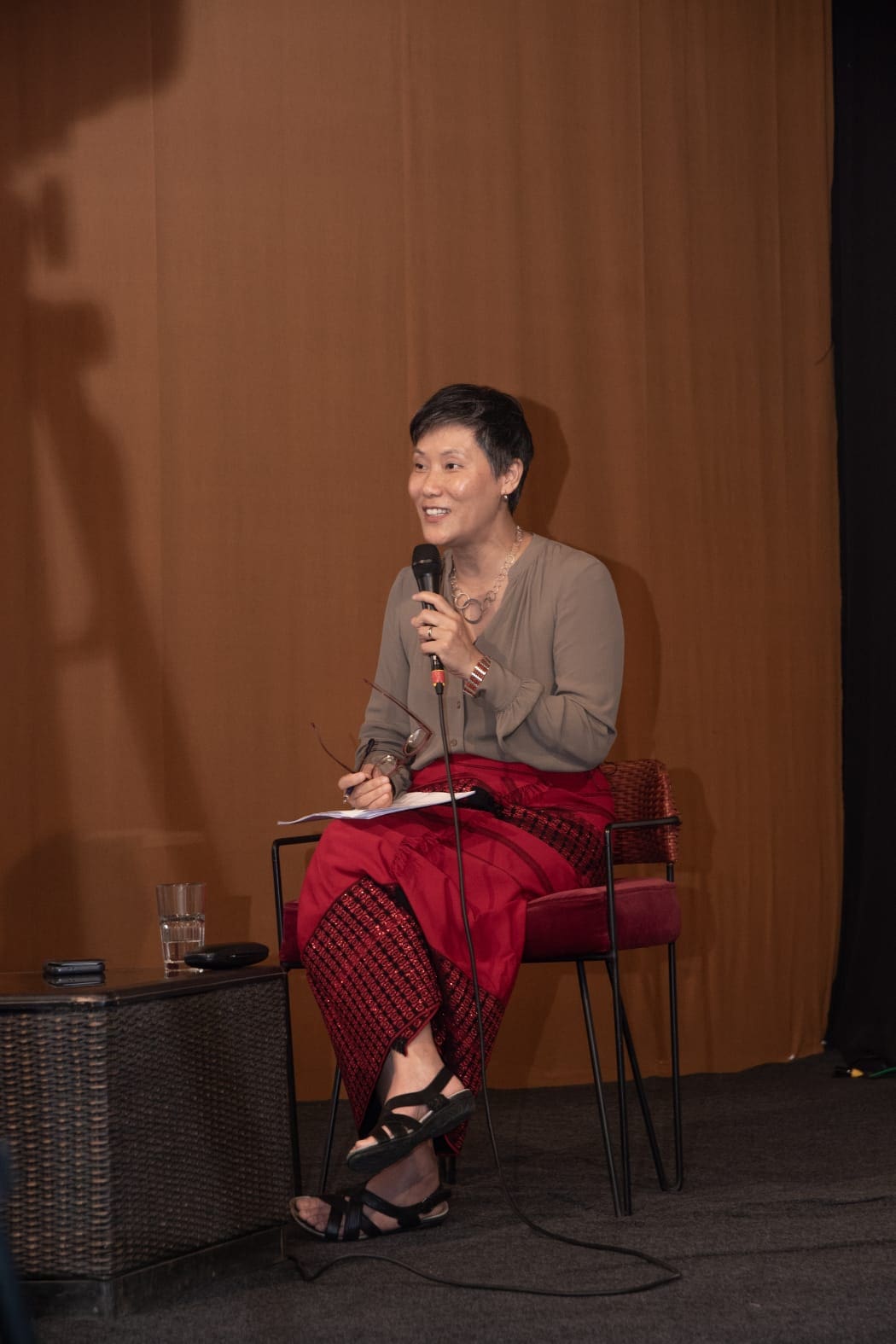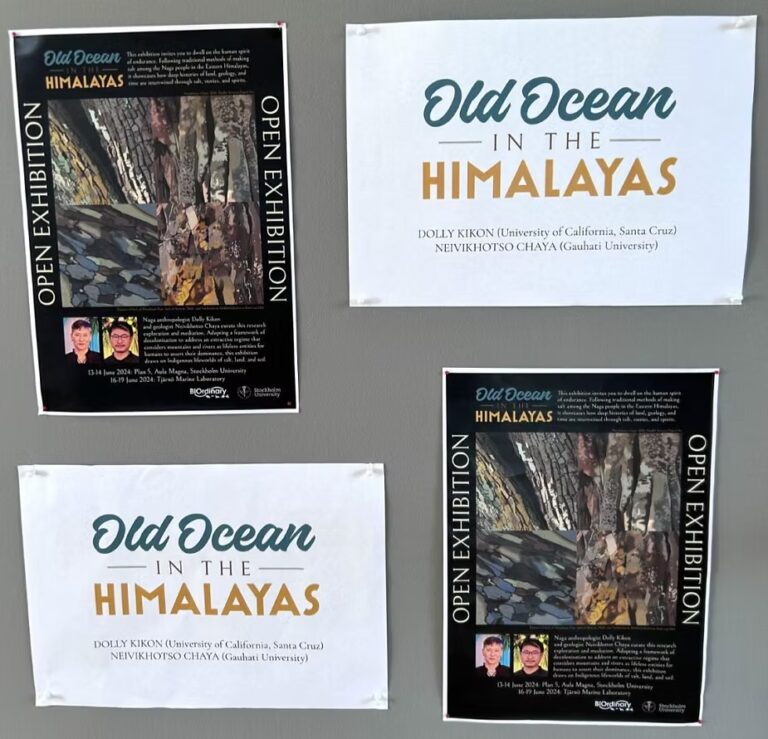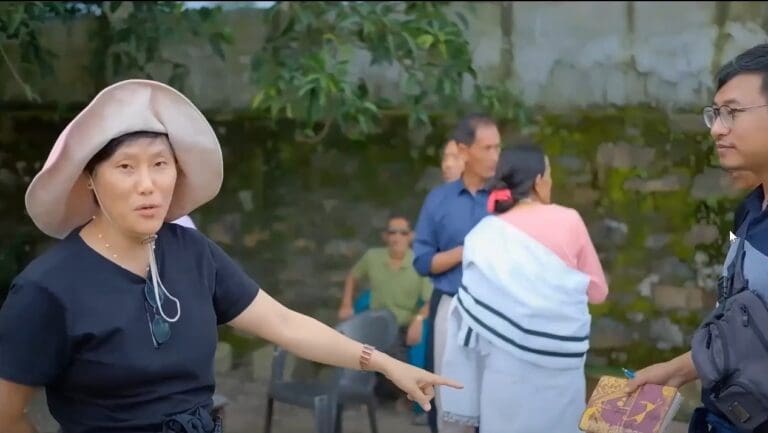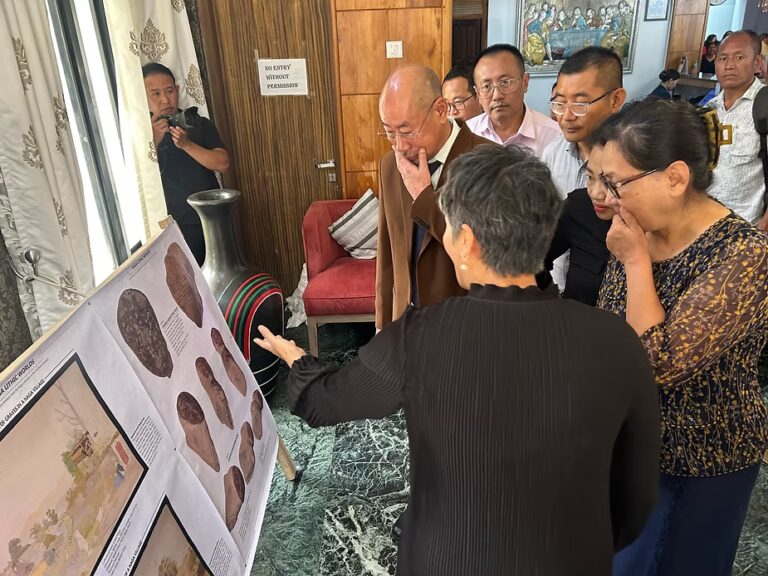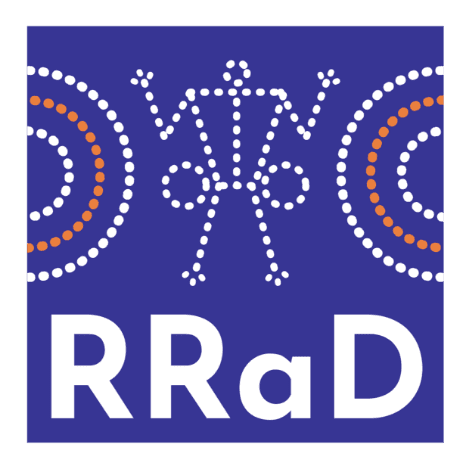How do Nagas begin the journey of bringing ancestral human remains back to their homeland and how can such a process enable healing and decolonisation?
“The journey begins with the realisation of our realities today,” asserted noted Naga Anthropologist Dolly Kikon in an in-depth presentation, titled, ‘Naga Ancestral Remains, Repatriation and Healing of the Land,’ during the Morung Lecture XIV here at Room03, Dimapur. The Morung Lecture is an initiative of The Morung Express.
The repatriation pertains to Naga ancestral human remains at the Pitt Rivers Museum (PRM), of University of Oxford in England, which displays diverse archaeological and anthropological collections. The Forum for Naga Reconciliation is the facilitator for the ongoing dialogue on repatriation.
Largest Naga Collection
According to Kikon, the Museum possesses the largest Naga collection in the world with approximately 6466 items comprising human remains and artefacts such as textiles, baskets, and jewelleries.
Out of this, around 213 are ancestral human remains.
The trigger to the current journey, however, began internally during the COVID-19 lockdown when the Museum decided to take down the Naga human remains from public display after being exhibited for over a century.
Categorised as “insensitive displays that highlighted the violent history of colonialism and imperialism,” and perpetuating colonial stereotypes and racism, the process was part of the Museum’s larger goal of decolonising the museum and aimed at redressing and healing.
The Museum, then noted, that the urgent priority to portray cultural objects in an ethical and sensitive manner started by initiating conversations with communities and prioritising reconciliation and co-curatorship with source communities.
In the case of Naga ancestral human remains, it was the Naga people.
Difficult Process
Accordingly, Kikon has collaborated with fellow Naga anthropologist Arkotong Longkumer and started a conversation with PRM in a “spirit of dialogue and decolonisation.”
Our aim in this initiative at the moment is to address issues surrounding the repatriation of around 213 Naga ancestral human remains, she stressed.
As indigenous anthropologists, the initiative resonated with our vision and values, Kikon said, adding; “We identified themes of decolonisation, healing, and reconciliation that powerfully encompass global indigenous values in the 21st century.”
She also acknowledged that the process will generate deep emotions including grief and anger, and open historical trauma as well.
For more than 100 years, museums across Europe have displayed Naga objects as exotic and primitive, taken away as souvenirs and artefacts under duress during colonial expeditions, she said.
Reparation to Decolonisation
Meanwhile, on a larger scale, the current initiative is seen as an intellectual pursuit “where all of us can create new forms of indigenous knowledge that allows us to seek interventions.”
Sharing from her own experience, Kikon noted that she grew up hearing how the “authoritative book on my tribe, the Lotha people,” was written by a British colonial administrator James Philip Mills (JP Mills).”
She recalled starting her journey as a researcher around 20 years ago and seeing the book in many educated Naga homes and how many elders would tell her to refer to JP Mills to “learn about my people.”
Besides him, others such as JH Hutton also extensively wrote about the Naga people, and the PRM officially acknowledges that the largest Naga collections at the museum were donated to them, she informed.
It is now acknowledged that many artefacts collected by colonial officers like Mills and Hutton were carried out under duress and often against the wishes of the Naga people, she argued.
Accordingly, as a Naga scholar, Kikon expressed her strong feeling that “producing meaningful education and scholarship in Naga society is about centering the inter-generational Naga indigenous world around us.”
Challenging task
However, she admitted that it would not be an easy task by posing: “How can we get a sense of indigenous values for communities who are experiencing intergenerational trauma due to militarisation and conflict? What kind of stories and lived experiences matter for us?”
Kikon said Indigenous cultures across the world, including that of the Naga people, believe that oral traditions and past are kept alive within the community – in the body, heart, and spirit of its members.
However, many in the Naga research world were fed healthy doses of colonial ethnographies written by Mills, Hutton, and others; “Colonisers who raided, invaded, burnt, and punished our people were also exalted as Naga experts for more than a century,” she said.
She also pointed out that while many items in the museums were gifts and tributes, there are also many items including the human remains that were collected after “punishing the savages”, imprisoning them, and burning down Naga villages; calling it “theft of Naga cultural artefacts and heritage.”
Stating that she was sharing these accounts with a reflective spirit of tracing the impact of colonisation, Kikon emphasised that besides taking over our soul, body, and land, we must acknowledge that the colonisation of the mind is the most brutal of all.
She added that a critical tool of colonisation is research that appropriates indigenous stories, histories, and sources to elevate the coloniser as an expert.
Accordingly, a “colonised Naga mind” sees knowledge, value, and any kind of intellectual meaning-making as grounded and exalting the superiority of the coloniser’s race and their history, she said.
To this end, there is “blind devotion and celebration” of colonial administrators, including an annual lecture, she added.
As a Naga anthropologist, in the spirit of decolonisation, this is something that deeply troubles me, Kikon declared, further calling upon Naga scholars and their allies to devote their time to decolonising Naga indigenous research and scholarship instead of getting drowned in a colonised mindset.
“Naga people will not celebrate the perpetrators of Oting in 2021, or celebrate those inflicted violence on Oinam, Kohima, and Mokokchung. So, I wonder, why do we exalt those who relegated us to intellectual primitivity and colonised us?”
For Kikon, the Naga Human Remains initiative is not limited to decolonising Naga scholarship but also a transformative process of learning to unlearn.
We stand here as fellow researchers with the larger indigenous research world-thinking together how to communicate and value community centred knowledge and engagement and deep meanings of decoloniality, she said.
Decoloniality involves recognising the Naga people’s history as one of colonisation and loss, and with the process of repatriation, Naga people have a remarkable opportunity to reflect on the future of the Naga ancestral human remains at the PRM and other museums in Europe and beyond, she added.
It is a process of thinking together how research, writing, and documenting are carried out with respect and accountability; actions and collaborations that shapes a holistic intellectual indigenous knowledge system, she asserted.
“The realities of colonialism are widespread. But the movement for justice and decolonisation persists.”
Healing route
Like many of these instances demanding restitution, the Naga people’s case requires understanding the immense violence and trauma we continue to experience because of colonisation, Kikon said.
It is not metaphorical, but needs to be embedded in a process where the community takes ownership and custodianship, and through that, hopefully, there is a more humane approach towards decolonisation and justice, she added.
She cited the example Naga photographer Zubeni Lotha’s exhibition “Looking at the Tree Again” in 2017 which interrogated the representation of Naga people in early Anthropology.
Taking the image of a Peepal Tree from a Lotha village, Zubeni showed how the tree serves as a social space, instead of a place for ‘trophies of human’ as depicted in colonial narration, she said.
Kikon opined that such initiatives that are taking place among Naga people resonate with the ‘healing of the land’ journey, adding that it was a sentiment that surfaced in many conversations with Naga individuals and communities since the beginning of the human remains dialogue.
Engaging with the ancestral remains and putting them to rest means a renewal of the land, and an understanding of the tempestuous historical moments that have come to define the Naga people, she argued.
For her, it is a task that requires reflection about the past and a hope for a future that the younger generation can inherit. She said the Naga human remains stored away in perpetuity “invites us to introspect and connect with our culture, land, and past.”
Emphasising on the importance of homecoming, she highlighted how Naga migrants ‘returned to their people’ – their villages, towns, and cities – during the COVID pandemic and how many Nagas volunteered in different ways to assist them.
“We witnessed what it meant to work towards a shared destiny. There is something sacred and spiritual about homecomings,” Kikon underlined.
When we understand our past, recognise the present reality, and strive to work together, we begin to build our future. This is when the work of decolonisation begins for us as responsible thinkers and members of the Naga nation, Kikon added, calling upon the Naga people to join the journey.
First published in The Morung Express News/July 27 2022.
Web link: https://morungexpress.com/decolonisation-and-restorative-justice


